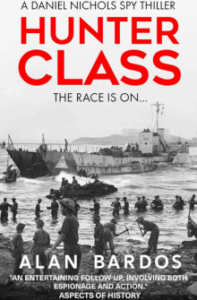Hunter Class is the second novel in your Daniel Nichols Spy Thrillers series. What has happened to Nichols since the end of Rising Tide and the beginning of the new book?
Nichols has been recruited into 30 Commando by Ian Fleming, a unit the Bond creator formed to carry out specialist operations to ‘pinch’ enemy intelligence and technology.
Nichols was with 30 Commando when they were first deployed during the disastrous Dieppe raid, where he didn’t get off his landing craft. He had more success when 30 Commando took part in Operation Torch; landing in Algiers, he captured an Enigma machine and intrigued against the Vichy French. However, the novel starts with Operation Husky, the invasion of Sicily, where Nichols’ hunt for vital enemy technology and intelligence material really begins.
Tell us about the plot, what is the mission?
Hunter Class is loosely based on the real-life exploits of 30 Commando in Sicily and the Bay of Naples area. It is a departure from my previous novels, as it is not completely structured around real historical events or people, and most of it is fiction.
After the fall of Mussolini, Nichols and his section join forces with Giacomo Moretti, a combat swimmer in the Italian Navy’s elite Decima Flottiglia MAS, to collect top secret Italian underwater technology before it is either destroyed or falls into German hands.
However, the real prize comes from Section Officer Prudence Tiverton, a WAAF officer who is tracking a German T52 Geheimschreiber (secret writer) teleprinter. Tiverton works in the background, silently pulling the strings, and sends Nichols off on a treasure hunt to find the T52.
Ian Fleming makes cameo appearances in the novel. How did you decide which real figures to weave into the narrative, and what liberties did you take for dramatic effect?
Ian Fleming was the Personal Assistant to the Director of Naval Intelligence and formed 30 Commando Unit and as such he takes on the role of ‘M’ in the novel, directing Nichols and giving him his missions. He also supports Tiverton in her search for the T52 after her CO dismisses her ideas.
Ian Fleming was the Personal Assistant to the Director of Naval Intelligence and formed the 30 Commando Unit. As such, he takes on the role of ‘M’ in the novel, directing Nichols and giving him his missions. He also supports Tiverton in her search for the T52 after her commanding officer dismisses her ideas.
When I discovered that the SAS (or SRS, as they were called then) were in Augusta at the same time as 30 Commando during the invasion of Sicily, I knew that my next book must include Blair ‘Paddy’ Mayne, who led his men in a heroic landing at Augusta. Nichols meets him in the mayhem after their landing.
Nichols’ section in the book is fictional, but a couple of real members of 30 Commando are mentioned: Lieutenant Commander Quintin Riley and Lieutenant Jim ‘Sancho’ Glanville, whose experiences helped inspire the book.
Inevitably, I had to take some liberties by bringing my fictional characters into their orbit and placing real people in situations where they may not have been. However, when I did not have much source material on a character and had to take greater liberties with their words and actions, I substituted real people with fictional characters.
Prudence Tiverton is a very determined character who never gives up her search for the T52, despite the cynicism of her superior. What is it that drives her?
Prudence was inspired by the extraordinary women of Bletchley Park and the Y Service who worked largely in the shadows but who made a significant contribution to the codebreaking carried out at Bletchley Park.
Before the war, Prudence was a languages scholar and learnt to ignore the demeaning remarks from crass, self-important men and angry, thin-lipped women who were threatened by her single-minded pursuit of precision.
When the war started, Prudence used her fluent German to become a listener for the Y Service. She spent the early years of the war listening to the static hiss of Morse code and transcribing Enigma transmissions. Prudence’s obsessive nature pushed her until she could not bear it anymore.
Prudence moved to a new section and became an expert in the analysis of German radio traffic. She then discovered the new ‘music’ of the T52, which burst out of the atmospheric dross with infinite precision. Through its high-speed bleeps, Prudence found a way for the Allies to gain the edge in the war.
What is the significance of the T52 Geheimschreiber (secret writer). What drew you to this particular piece of wartime technology?
The Siemens & Halske T52 was a teleprinter that used ten rotors to generate a code significantly more complex than the code produced by the Enigma machine’s three or four rotors.
Its code was so complex that Hitler used it to send his most sensitive communications to his senior Luftwaffe commanders. Bletchley Park gave it the codename Sturgeon and managed to break it. However, it was a long and painstaking process.
The codebreakers instead focused their attention on the equally complex code produced by a second type of secret writer called the Lorenz SZ-40/42, which was codenamed Tunny. Tunny was used by the Wehrmacht and was therefore considered to be a more valuable use of resources. During the Italian campaign, Bletchley Park concentrated much of their effort on breaking this code, as Enigma traffic was sent by landline and couldn’t be intercepted, making teleprinter traffic their main source of intelligence.
This gave me the opportunity to use some artistic licence and allow my characters to discover a quicker way of breaking Sturgeon.
What inspired the Giacomo Moretti character, and what was his specialist unit?
Giacomo was inspired by the men of the Decima Flottiglia MAS, an elite Italian naval commando unit that carried out several remarkable raids during WWII. The most famous of these were attacks on merchant shipping in Gibraltar Harbour, and on HMS Valiant and HMS Queen Elizabeth in Alexandria Harbour.
The specific example I use in the book — and which inspired Giacomo Moretti — is one of their clandestine missions against Allied shipping in the neutral port of Alexandretta, on Turkey’s Mediterranean coast. It was carried out by Sub-Lieutenant Luigi Ferrar, who swam out to Alexandretta’s harbour and placed two limpet mines on the steamship Orion.
What have you got planned for your next book?
My plan at the moment is to take Nichols and his men into D-day campaign and the hunt for Hitler’s Wunderwaffe, ‘wonder weapons’.
Alan Bardos is the author of historical fiction set around the World Wars. His latest novel is Hunter Class.







